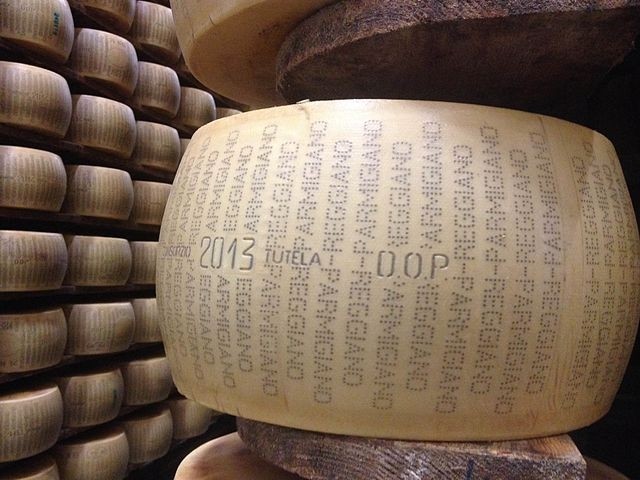Parmigiano Reggiano Cheese P.D.O.
Product description
Parmigiano Reggiano PDO is a cooked and un-pressed hard cheese, produced with raw cow’s milk obtained from animals reared in the production area and fed mainly on local fodder.
Production method
The cheese is produced with milk taken from the evening milking, which is left to rest overnight in steel vats.
After it has been partially skimmed, the evening milk is added to the morning milk in a characteristic copper boiler in the shape of an upside down bell, without any type of additive. The whey is then added to the milk and the mixture is heated to a temperature of 33°C.
Calf rennet is then added and the milk is curdled for 12-15 minutes. The curd is broken into small grains before being cooked until it reaches a temperature of 55°C.
After the grains have settled, the mass is lifted out of the boiler and cut in half; each half is wrapped in a linen cloth and put into wooden or metal molds, where the cheese obtains its characteristic shape and a casein marker is incorporated into the rind; the alphanumeric code unequivocally identifies each single wheel.
The wheels are then marked with a special marking stamp, which embosses the dotted inscription “Parmigiano Reggiano”, the serial number of the dairy and the production date and year on the rind. This is followed by the salting process, which involves the wheel being immersed for 16-20 days in a natural saturated salt solution.
The wheels are then left to ripen on wooden shelves in a temperature and humidity controlled environment; this stage can last anything from 12 months to two years.
Only cheeses which pass a strict selection are marked with the oval fire brand after 12 months of ripening.
Apparence and flavour
Parmigiano Reggiano PDO has a cylindrical shape with a diameter of 35 to 45 cm and a height of 20 to 26 cm.
The wheels weigh at least 30 kg and have an average weight of 40-42 kg. The rind is natural golden yellow in colour.
The cheese is hard, with a colour that varies from pale to deep straw yellow; the texture is minutely grainy and flaky.
It has a delicate flavour and a fragrant aroma that is savoury but not piquant.
Gastronomy
If vacuum-packed, Parmigiano Reggiano PDO should be conserved in the fridge at a temperature of 2-8°C; If not, it is best to keep it vacuum-sealed or in transparent plastic food bags. Particularly versatile thanks to the different levels of ripening, it is the main ingredient for many recipes that are part of Italian tradition. It can be consumed as a table cheese, eaten on its own, or served with vegetables, salads and fresh fruit or nuts. It is ideal for grating over pasta, minestrone and consommé.
Marketing
The product is marketed as Parmigiano Reggiano PDO in the following typologies: Mezzano (2nd selection, ripened 12-15 months); Parmigiano Reggiano PDO (ripened 12-24 months or more); Parmigiano Reggiano PDO Extra (only on request, ripened for over 18 months, for national and overseas markets). In order to identify the age of the cheese, it is possible to indicate the months on the label or use the coloured seals of the Consortium: Lobster Pink, over 18 months; Silver, over 22 months; Gold, over 30 months. It is sold year-round, whole, in large pieces, in pre-packed slices, and grated.
Distinctive features
The processing method of Parmigiano Reggiano PDO is substantially the same as it was nine centuries ago, and uses the same basic ingredients (milk, rennet and salt), without any additives.
History
The origins of Parmigiano Reggiano PDO date back to the Middle Ages, thanks to the work of Benedictine and Cistercian monks in the Po Valley, who, between the Apennines and the right side of the River Po, reclaimed the wetlands and started cultivating the fields with the cereals, hay and pasture necessary to feed the cows.
Production area
The production area of Parmigiano Reggiano PDO is within the territory of the provinces of Parma, Reggio Emilia, Modena and Bologna (on the left side of the River Reno), in the Emilia-Romagna region; the Province of Mantua on the right side of the River Po, in the Lombardy region.
Operators: 4.142
Production(KG): 125.073.750
Turnover(MLN€): 1272,72

 IT
IT 